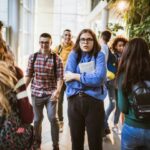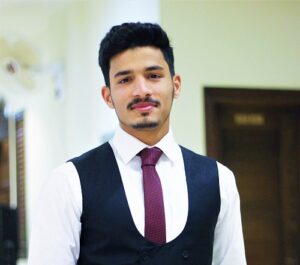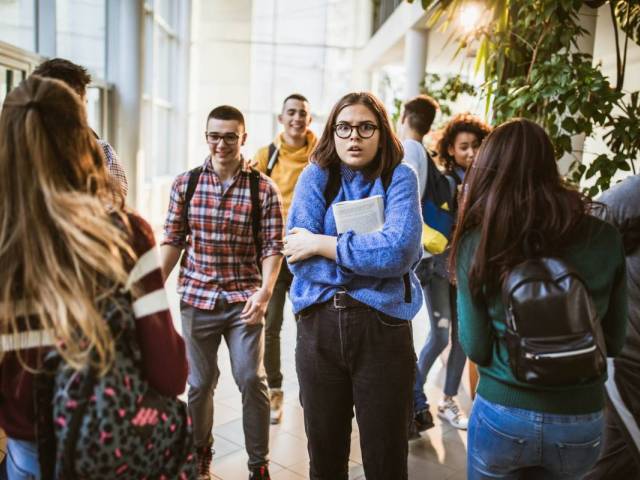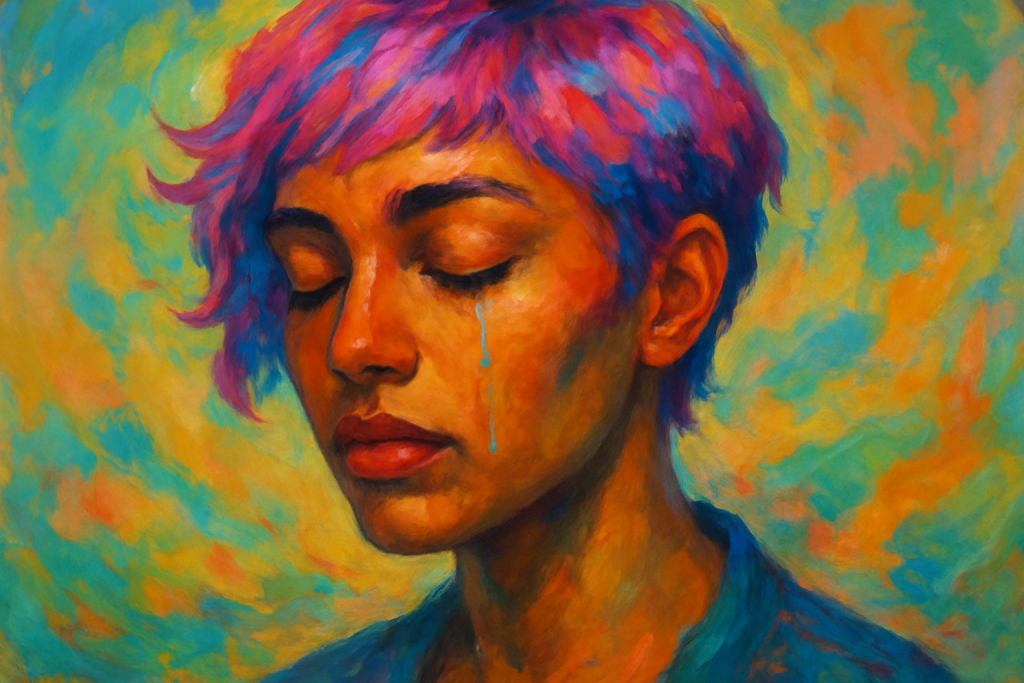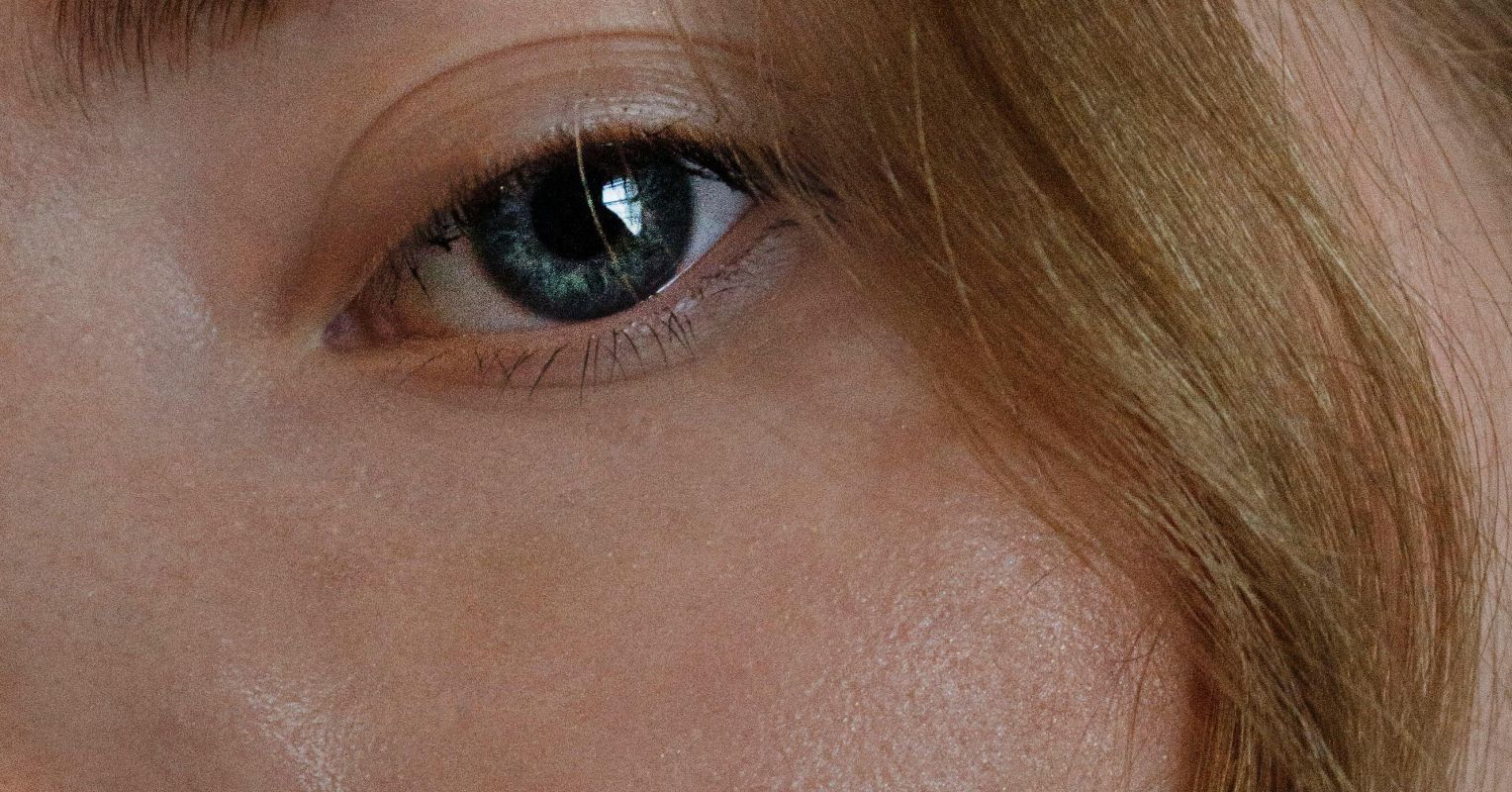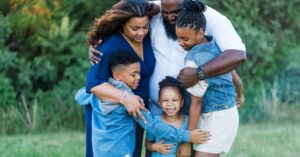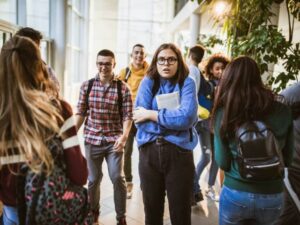Student suspensions across the country. Police in riot gear called on to dozens of campuses. Presidents of top universities called into congressional hearings. Those were the top higher education stories during the past year.
But there were also many students, faculty, and staff committed to fostering a culture of understanding and belonging across higher education. The Greater Good Science Center’s Bridging Differences program has been giving them as much support as possible, by sharing research-based strategies for better relationships, dialogue, and understanding across political and social divides. So far, more than 200 campus leaders—faculty, staff, and administrators—have participated in an eight-month facilitated virtual program called the Bridging Differences in Higher Education Learning Fellowship.
During the fellowship, campus leaders get to sharpen their bridging skills and learn strategic tactics and practices from each other. From classes that led to white students in Alabama reflecting on their visits to Black churches, to Penn students listening and understanding anti-immigrant sentiment in off-campus small-town trips, to Democratic students in Utah leading and building containers for tricky conversations with Republicans on campus. These initiatives have proven a critical space of learning and scaling hope for the divisive time we find ourselves in.
Samford University, Alabama: Introducing bridging on campus early
X
“More colleges, universities, and schools are prioritizing bridge-building in their coursework and freshmen orientation,” explains Jonathan Thigpen, GGSC Bridging Differences in Higher Education fellow and the assistant dean for curricular innovation and professional development at Samford University’s McWhorter School of Pharmacy in Alabama. “I’m optimistic about the way higher education is moving in these areas, but I think the next step is taking that momentum and doing more work.”
Thigpen believes that while “most people in academia want to bridge,” that can take time, intent, and skills they don’t necessarily have. “What I loved most about the GGSC program is it helped us operationalize our ideas, we had to break it down step by step. We did that every month. Breaking bridging into smaller components made it more feasible.”
Thigpen thinks apprehension is a crucial barrier to mitigate. “Students are afraid to put themselves in uncomfortable situations,” he says. “But they are also pretty curious about each other. There is a large desire for connection. It’s just a matter of them feeling comfortable to do it. It’s about rewarding their innate curiosity.”
To do this, there is a mandatory class at Samford University for pharmacy students called Foundations of Health and Pharmacy II. Students visit and write a reflection piece about a culture that is truly “other” to them and that they are genuinely curious about. This has resulted in Protestants visiting a mosque service, a student attending a family night at an eating disorder clinic, a female student going to a male-dominated car auction, a student attending a traditional Japanese birthday party, and a white-collar student reflecting on their time at a blue-collar cafeteria.
“The most common theme I see is that students talk about how they were afraid to interact with that other culture, but once they interact they unequivocally love it,” says Thigpen.
The key is addressing their concerns and not ignoring them. Thigpen explains the first step is often the hardest for students—but from a personal development perspective, you want them to embrace the challenge. “You have to take the time to prepare them for it. And when they feel prepared, they feel comfortable taking the leap.”
In the future, Thigpen would like to develop longitudinal cohorts of students who, over time, can meaningfully grow their attitudes and skills surrounding bridging to overcome race, ethnic, gender, political, and philosophical differences both within their group and external to their group.
University of Maryland: Creating “containers” to have difficult conversations
“In our culture, higher education is one of the only places where there can actually be real conversations about difficult topics,” says Beth Douthirt-Cohen, a public health professor at University of Maryland, College Park, and a GGSC Bridging Differences in Higher Education fellow. “It is not going to happen in your workplaces. It’s not going to happen when you get into your very segregated neighborhoods.”
An act of violence spurred her work at the University of Maryland. In 2017, a University of Maryland School of Public Health student, Sean Urbanski, killed another student named Richard Collins III, who attended Bowie State University, the oldest historically Black university in the state of Maryland. Collins was Black and Urbanski was connected to white nationalist groups. Urbanski was sentenced to life, but since then, the university has been engaged in a truth, reconciliation, healing processes with the Collins family and Bowie State University, while setting up the infrastructure and spaces to have difficult conversations about preventing identity-based hate on campus.
The University of Maryland School of Public Health brought Douthirt-Cohen to build the capacity of students, faculty, and staff to engage across power and identity differences, in healthy and ethical ways.
So when the mass Gaza solidarity protests swept campuses across the country last year, Douthirt-Cohen was already deep into building processes within the university.
“It’s been more complicated than I had previously experienced in my career,” she says. “We had ongoing protests, but we did not have the same level of altercation that occurred in other institutions despite us having student populations deeply connected to Palestine and Israel.”
She believes that this was partially because student and campus religious leaders were “very engaged and open to building relationships even in difficult moments. It made me realize how important those infrastructures and relationships are amongst various people and groups before difficult moments happen.”
Douthirt-Cohen got feedback that these partnerships and interventions built capacity for difficult conversations across differences and therefore were crucial to preventing escalation. The campus had students with relatives killed in the war in Gaza and a student whose cousin was taken hostage on October 7, and later killed.
For Douthirt-Cohen, the crux of it was two marginalized yet large populations of grieving Palestinian, Muslim, Jewish, and Israeli Americans at their predominantly Christian institution. Questions she asked herself were: What could the process of building steps toward a relationship look like? And do students want that? And how do we create a container for that? She explained that in our culture there is an orientation toward crossing divides out of pity, charity, or to be seen as a good person, but that is not helpful to building meaningful connections.
“It has to be connected to our own survival and our own sense of humanity to stay in the work. I deeply believe in interest convergence in doing this work long term. That’s the way I approach this work: what is your interest in this work and what is your self-interest in this work? How do I support you in identifying that and naming that? Especially, for people who have historic and contemporary privilege, there has to be self-interest for when it gets difficult to stay in the harder conversations,” says Douthirt-Cohen.
And that is what she’s been doing on campus with 300 students over the last year, through classes and educational interactions building “containers” that are focused on interest convergence, and training facilitators.
Most students she interacts with are oriented toward this idea that there are just superficial differences, but Douthirt-Cohen believes there are profound differences between humans that need to be addressed. For her it’s important to create spaces where we can really build that skill in our culture to have a really difficult conversation and stay in it. And it’s been successful. “They did not invalidate each other by saying we agree to disagree. They think about how we can stay in this conversation and still see each other’s humanity while speaking our own truth.”
Students are given tools around mindfulness and Self-awareness of how they can take care of their bodies to do the work they want to do.
Douthirt-Cohen co-teaches a course with psychologist Carlton Green, on racial trauma and racial healing, where students have difficult conversations about how race-based stress and trauma live in our bodies. “A lot of the work I do is around Self-awareness and skill building. And work around changing our policies, practices, the questions we ask. What are unnoticed barriers, where are our gaps in racial equity?” Douthirt-Cohen leans on the work of Glenn Singleton, author of Courageous Conversations About Race, who has a framework of four agreements to facilitate difficult conversations, including staying engaged, experiencing discomfort, speaking your truth, and expecting and accepting non-closure. “More recently, students find discomfort and not having closure the hardest,” she says.
Brigham Young University, Utah: Nurturing bridging leaders

Jeff Glenn, GGSC Bridging Differences in Higher Education fellow and associate professor of public health at Brigham Young University
For Jeff Glenn, another GGSC Bridging Differences in Higher Education fellow, conversation guides are crucial. “The key is that we have conversation guides, self-directed, that give structure and conversation agreements about being honest, respectful and owning the conversation,” says Glenn, associate professor of public health at Brigham Young University.
Glenn has been leading crucial work on divisive topics in Utah through a program called Campus Conversations. “More people are moving to places where people think like them,” says Glenn. “It’s a lot easier for everyone to stay in their own bubble. I worry that we are going to get caught in a vicious cycle, because we get more and more stuck within our own bubble.”
Initially, Glenn’s program roped in Living Room conversations, a project by the nonprofit Mediators Foundation, to help train students to facilitate structured dialogues in classrooms.
Now, more than 50 students are trained and they hold classroom events where professors get to choose the topics, which have included divisive COVID-19 public health policies and racial equity issues.
Jack Manue, a Black undergraduate studying public health and leadership, is a program coordinator for Campus Conversations. “At BYU, we don’t have a lot of diversity. I joined this program so that everyone is heard. Every voice is important.”
Manue initiated a process to bring faculty into mandatory writing classes for freshmen to do the dialogues, which really helped scale their operations to over 1,000 students.
Glenn explained that trained facilitator students are crucial when things go south, and they have become skilled at intervening and reminding participants of their conversation agreements, such as being respectful and owning the conversation.
“This work resonates with undergraduate students and they want to make things better, they want to learn and help others have dialogue across divides. And bring us back from this place we’ve increasingly been sucked into,” he says.
For Glenn, these freshmen interventions are key, because when students self-select to participate in bridge-building, you risk an echo chamber. But when you get diverse students together under conversation agreements, magic can happen.
“It is very rewarding to know that I’m making a difference,” says Manue. “Not just in my campus life, but on a bigger scale, because after the students go home, they take this information and what they learn about having a more meaningful conversation and actually implement that with their family, and that has a ripple effect and shines goodness on everybody.”
University of Pennsylvania: Taking bridging off campus

Lia Howard and her team at the Political Empathy Lab traveled around Pennsylvania in summer 2024 to listen.
© Photo courtesy of the Political Empathy Lab Summer 2024. SNF Paideia Program, University of Pennsylvania
And that is what Lia Howard, GGSC Bridging Differences in Higher Education fellow and fellows director of the SNF Paideia program at University of Pennsylvania, found as well: “In my classroom, I build a lot of trust.”
Howard runs the Political Empathy Lab, where during summer 2024 students traveled to different parts of Pennsylvania over 10 weeks and deeply immersed themselves in conversations with people at parks, libraries, and county fairs.
“You don’t have to go far in Pennsylvania to experience intense differences,” she says. “It is geographically siloed in certain areas, interaction almost has to be intentionally created, otherwise it won’t happen on its own. We expected to get rejected a lot more than we actually did. But many of our students had hour-long conversations. Their empathy grew, their ability to listen grew.”
Off the bat, Howard’s students would inform people that they were not canvassing or polling. They’d say, “We are listening,” and then invite people to share with them.
Leading up to the conversations, Howard would help build their strategic skills around having conversations across differences. “One of the early conversations I had with students was that they might be the only person of their racial or sexual orientation in the places we went to. I selected students based on their willingness to engage even if they were not demographically represented.”
The conversations were transformative for her students. “Walking up to a stranger in a place you’ve never been is hard,” she says. “You have to be really brave and shut out the noise and focus on one human being. We’d be driving back and there was so much generated by their courage and from hearing each other’s stories.”
The first conversation was really hard. But once they conquered their anxieties, and once they had a good conversation, the next one was exponentially easier, explains Howard. “I had my students travel in pairs, someone else was in it with them and helped them stay accountable.”
Howard believes the students had a lot of success because of the loneliness epidemic. “You may be surprised how many people are willing to be listened to,” says Howard. “Bridging work can also meet the loneliness issue in America right now.”
In Erie, Pennsylvania, where most residents are native-born and there are few immigrants, the sentiment was sometimes hostile toward immigrants.
“So we’d hear a lot of things that people were articulating as the causal explanation as to why there were problems, but it wasn’t actually reflected in their town,” says Howard. “Several students in our group are children of immigrants themselves and had really interesting conversations with folks.”
Her students would say something like, “I am the child of an immigrant or this is my experience, which sounds a little bit different than what you’re describing.” Howard says that most of them felt good about the conversations that ensued; often, folks from Erie would trace back their misgivings about immigrants to one media outlet, and some would realize that they need to diversify their sources.
After the students were done with their listening sessions, they’d meet with someone who lived and worked in the area to add another layer to that experience. It could be a business owner or a school board member, and the students would run their observations by that person.
The students captured 45 hours of live audio during their sessions and are producing a podcast series from it and presenting their learning on and off campus. “A big dream would be for all Penn students to travel outside Philadelphia around the state,” says Howard. “There are so many different stories and ideas in the different media markets.”
Douthirt-Cohen agrees. Universities can pave the way for a more connected, compassionate, and resilient generation by developing containers, programs, and spaces for deeper conversations.
“People need to go on their own journeys around identity, power, and privilege,” says Douthirt-Cohen. “We often want to rush people to act in the interest of communities more marginalized than them. We sometimes need them to act faster. But what does it mean to sit with each other longer term? To create spaces and ways for people to have pathways to say what they are thinking, say what they’ve learnt throughout their life, and have real conversations about it.”
By equipping students with the tools for constructive dialogue, universities are not just addressing campus divides—they are laying the foundation for a more connected and compassionate society.

